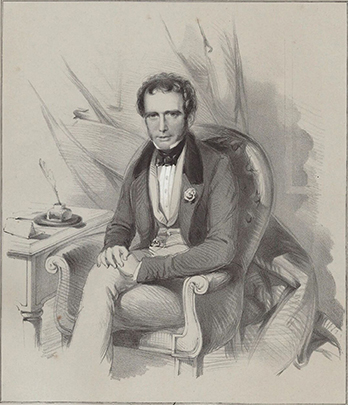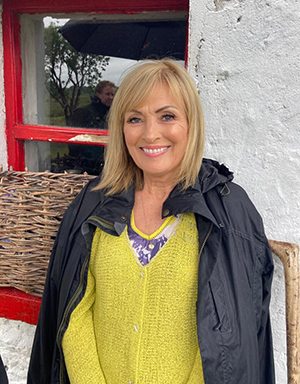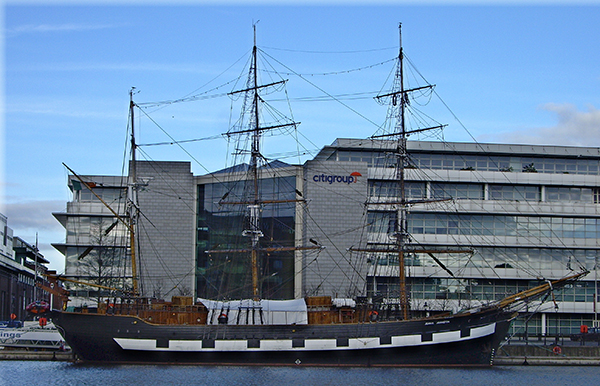An tSlí
Published in Issue 1 (January/February 2022), Reviews, Volume 30RTÉ1, 26 October and 2 November 2021
By Donal Fallon

Above: Strokestown landlord and mass evictor Major Denis Mahon, who was assassinated in November 1847.
In the ever-growing field of Museum Studies, much is written on outreach and the importance of museums taking their knowledge out of their own four walls and into broader communities. Over two parts, An tSlí demonstrated the manner in which the National Famine Museum at Strokestown House does just that, utilising the National Famine Way, a 165km route from Strokestown Park Estate to Custom House Quay in Dublin.
The story of how the National Famine Museum came to be would make an interesting documentary in its own right. In 1979, businessman Jim Callery purchased Strokestown House with the aim of using its grounds for his growing truck business. As the Westward Motor Group grew, tensions developed between Callery’s ever-expanding operation and the Pakenham Mahon family at neighbouring Strokestown Park. Callery purchased the grounds and home from the family in 1979 for about £400,000. While he initially intended to give little thought to the house, the discovery of more than 50,000 documents in it—many relating to the years of the Famine—would change the course of his life.
An tSlí takes broadcaster Mary Kennedy on a journey that begins in discussion with Callery and ultimately concludes at the Jeanie Johnston replica famine ship on Dublin’s quays. Taking a bilingual approach, the show is presented as Gaeilge with interviews in both English and Irish, demonstrating the potential for bilingual programming on the national broadcaster’s main channel and beyond the more comfortable surroundings of TG4.
An tSlí follows Mary Kennedy—in the company of Famine authority Cathal Poirtéir and the National Famine Museum’s Caroilin Callery—as she undertakes this scenic walk through Roscommon, Longford, Westmeath, Meath, Kildare and into Dublin, along the Royal Canal and in the shadow of the impressive Daniel O’Connell memorial tower at Glasnevin Cemetery. Thus, in format, it sounds not unlike Kennedy’s long stint on Nationwide, which was frequently dedicated to promoting heritage sites. An tSlí, however, is a much more ambitious undertaking, adopting a multi-disciplinary approach to bring its story to life, including historical re-enactment, song and drama.

Above: An tSlí follows Mary Kennedy as she undertakes this scenic walk through Roscommon, Longford, Westmeath, Meath, Kildare and into Dublin and along the Royal Canal. (RTÉ)
The context of the National Famine Way is the journey undertaken in 1847 by 1,490 people, who walked from Strokestown to the capital before embarking for Canada on a journey of ‘assisted passage’ that many did not complete. As Kevin Kenny has noted in The American Irish: a history, ‘158 of them died on board the Virginias out of Liverpool, 19 died waiting in quarantine off Grosse Île, and at least 90 more died in the hospital sheds on the island’. Their landlord, Major Denis Mahon, was assassinated in November 1847, a killing which the Freeman’s Journal described as ‘another bloody deed, the result of the agrarian war which is still being waged in all its horrors between Irishmen for the soil of Ireland’. In fact, the killing of a landlord was a rare occurrence in the years of the Famine, rare enough that this landlord’s death made it to the floor of the House of Commons and the international press. We see a dramatic and high-quality re-enactment of the death of Mahon, but the walk of his tenants is instead undertaken by the presenter and her guides.
Caroilin Callery and Cathal Poirtéir are authoritative voices on their subject, and clear believers in the ‘living history’ approach of museums, utilising historical re-enactment. They draw from primary source recollections of those who undertook this journey, stopping at points along the route to perform for interested local gatherings.
As the journey nears Dublin we are introduced to a series of performers, including singer Niamh Farrell, who gives us a moving rendition of ‘Thousands are Sailing’, a migration song from the pen of the late Philip Chevron of The Pogues. Yet the song—which references Brendan Behan, George M. Cohan and President Kennedy—is a broader tale of migrant sorrow, with little clear connection to the route. There is also an interview with Tom Sullivan, director of the acclaimed film Arracht, on the challenges of bringing the Famine story to the big screen. This second episode feels more akin to an exploration of the Famine—and broader migration—in Irish popular culture and memory than the National Famine Way itself.
As Kennedy and her guides enter the capital, we see a Dublin that is at once familiar and unfamiliar. There is something rural in the setting, as we meet a couple living in a small cottage by the Royal Canal who were already familiar with the story of the Strokestown walk and those who made the journey in the 1840s. Moving into a more familiar cityscape, we meet sports historian Paul Rouse, a familiar face in Irish documentaries but here, as Gaeilge, brilliantly discussing the 1947 All-Ireland final in the shadow of Croke Park. The game, however, was played in New York’s Polo Grounds, and we learn that player Peter Donoghue so impressed the American audience that he was christened ‘the Babe Ruth of Gaelic Football’ in the New York press. Once again, it feels like a broader migration/Famine narrative is being presented.

Above: An tSlí concludes at the Jeanie Johnston replica famine ship on Dublin’s Custom House Quay.
An tSlí concludes at Dublin’s Custom House Quay, where Jim Callery awaits the walkers. We see Rowan Gillespie’s striking sculpture, Famine, unveiled in 1997 at the site of the departure of the Perseverance, which sailed on St Patrick’s Day 1846. Much like Callery’s museum, Gillespie’s work reflected the increased interest in this story in the 1990s, on the 150th anniversary.
Undoubtedly, many who watch An tSlí will be disappointed to learn that the National Famine Museum is currently closed for redevelopment. Still, it intends to return in spring 2022 with a new focus and a state-of-the-art exhibition space. Jim Callery never intended to oversee a museum, but it is the good fortune of Irish history that he does. While An tSlí sometimes drifted from the National Famine Way, it nonetheless demonstrated how An Gorta Mór still shapes us as a people.
Donal Fallon is the author of 14 Henrietta Street: from tenement to suburbia (Dublin City Council, 2021) and the presenter of the Three Castles Burning podcast.
















